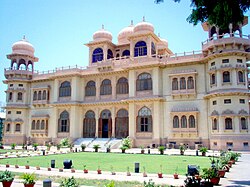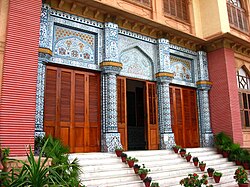 About
About
The Mohatta Palace (Urdu: مہتا پیلس) is a museum located in Karachi, Sindh, Pakistan. It was built in the posh seaside locale of Cliftonby Shivratan Chandraratan Mohatta, a HinduMarwari businessman from modern day Rajasthan in India, in 1927, as his summer home.[1] The architect of the palace was Agha Ahmed Hussain.[2] However, Mohatta could enjoy this building for only about two decades before independence, after which he left Karachi for India. He built the Palace in the tradition of stone palaces in Rajasthan, using pink Jodhpur stone in combination with the local yellow stone from Gizri. The amalgam gave the palace a distinctive presence in an elegant neighbourhood, characterised by Indo-Saracenic architecture. which was located not far from the sea.
The Mohatta Palace is located in Karachi, Sindh, Pakistan. It was built by Shivratan Chandraratan Mohatta, a Hindu Marwari businessman from modern day Rajasthan in India,in 1927, as his summer home.For ancient mariners, the delta of the Indus served as an important geographical landmark. Karachi continued as an entrepot for trade along both land and sea routes for several centuries, until the British began to expand their colonial administration under the aegis of the East India Company. Recognising the commercial and strategic importance of Karachi as a means of access to the entire north western flank of the sub-continent and beyond it, to Russia, they annexed Sindh in 1843.

The presence and authority of the British were reflected in the architecture they adopted for army cantonments, municipal buildings, churches and formal residences in Karachi. The late 19th and early 20th centuries saw new styles of architecture in the sub-continent that were a fusion of European, Victorian, Gothic and Mughal elements suited to local forms and materials. Karachi rose to prominence at an astonishingly rapid pace, attracting people from the north west, the Iranian plateau, Turkey and Central Asia and from the south east, especially Kutch, Bombay and Rajasthan.
Exterior details


Palace before (left) and after (right) renovation.
Mohatta Palace is an elaborate building with intricate details which are present in almost every portion of this magnificent building. These are in the form of carvings. The delicate designs include bird’s wings in the large windows, situated in the top right and left corners of the arches.
There are also peacock motifs in the stonework and they are found around each of the nine domes. Also, there has been a lot of use of the scallop shape in upwards and downward positions around the lower areas, in the form of a strip going around the building and on top of the first and second-floor windows that protrude outwards. There are also many floral motifs around the surrounding wall, between each scallop, such as marigolds. Hibiscus flowers to are found lightly carved between rectangular shapes underneath all the windows, which are on the sides of the doorways.


Palace before (left) and after (right) renovation.
Mohatta Palace is an elaborate building with intricate details which are present in almost every portion of this magnificent building. These are in the form of carvings. The delicate designs include bird’s wings in the large windows, situated in the top right and left corners of the arches.
There are also peacock motifs in the stonework and they are found around each of the nine domes. Also, there has been a lot of use of the scallop shape in upwards and downward positions around the lower areas, in the form of a strip going around the building and on top of the first and second-floor windows that protrude outwards. There are also many floral motifs around the surrounding wall, between each scallop, such as marigolds. Hibiscus flowers to are found lightly carved between rectangular shapes underneath all the windows, which are on the sides of the doorways.
Comments
Post a Comment